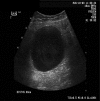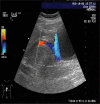Posttraumatic Aneurysm of a Patent Umbilical Vein: Diagnosis and Specific Treatment
- PMID: 28825034
- PMCID: PMC5553509
- DOI: 10.1055/s-0037-1604075
Posttraumatic Aneurysm of a Patent Umbilical Vein: Diagnosis and Specific Treatment
Abstract
A patent umbilical vein is a rare condition in healthy volunteers, but can be detected in up to 11% of patients with liver cirrhosis as a consequence of portal hypertension. We report the case of a 52-year-old woman who was admitted to our department with acute abdominal pain after blunt trauma to her forehead and abdomen. She had a history of alcohol abuse with liver cirrhosis that had been classified as Child-Pugh stage C 5 years earlier. Signs of portosystemic shunting had been present at an earlier endoscopy, and esophageal varices were found. Clinical examination revealed typical signs of liver cirrhosis, and ultrasound examination showed an aneurysm of 6 cm of the umbilical vein, which had not been present at earlier examinations. After lowering portal hypertension by inserting a transjugular intrahepatic portosystemic shunt, an open surgical resection of the aneurysmal umbilical vein was performed without complications. The patient recovered well and was discharged from the hospital 10 days later. We hypothesize that the abdominal trauma prompted or aggravated umbilical vein aneurysm in this patient with liver cirrhosis and portal hypertension. Due to the risk of rupture, a surgery-based resection is a valuable treatment option.
Keywords: TIPS; liver cirrhosis; patent paraumbilical vein; posttraumatic aneurysm.
Figures




Similar articles
-
Computed tomography evaluation of patent paraumbilical vein and its aneurysm in relation to other portosystemic collateral channels in patients with liver cirrhosis and portal hypertension.Pol J Radiol. 2019 Feb 12;84:e112-e117. doi: 10.5114/pjr.2019.83135. eCollection 2019. Pol J Radiol. 2019. PMID: 31019603 Free PMC article.
-
Portal vein aneurysm associated with Budd-Chiari syndrome treated with transjugular intrahepatic portosystemic shunt: a case report.World J Gastroenterol. 2015 Mar 7;21(9):2858-61. doi: 10.3748/wjg.v21.i9.2858. World J Gastroenterol. 2015. PMID: 25759562 Free PMC article.
-
CXCL9 is a prognostic marker in patients with liver cirrhosis receiving transjugular intrahepatic portosystemic shunt.J Hepatol. 2015 Feb;62(2):332-9. doi: 10.1016/j.jhep.2014.09.032. Epub 2014 Oct 17. J Hepatol. 2015. PMID: 25457205
-
[Recurrent bleeding from colonic varices in portal hypertension. The successful prevention of recurrence by the implantation of a transjugular intrahepatic stent-shunt (TIPS)].Dtsch Med Wochenschr. 1995 Dec 22;120(51-52):1773-6. doi: 10.1055/s-2008-1055541. Dtsch Med Wochenschr. 1995. PMID: 8549262 Review. German.
-
Current approaches to the management of patients with liver cirrhosis who have acute esophageal variceal bleeding.Curr Med Res Opin. 2016;32(3):467-75. doi: 10.1185/03007995.2015.1124846. Epub 2016 Jan 25. Curr Med Res Opin. 2016. PMID: 26804426 Review.
References
-
- Chen C H, Wang J H, Lu S N et al.Comparison of prevalence for paraumbilical vein patency in patients with viral and alcoholic liver cirrhosis. Am J Gastroenterol. 2002;97(09):2415–2418. - PubMed
-
- Zardi E M, Uwechie V, Caccavo D et al.Portosystemic shunts in a large cohort of patients with liver cirrhosis: detection rate and clinical relevance. J Gastroenterol. 2009;44(01):76–83. - PubMed
-
- Altinbas A, Sowa J P, Hasenberg T, Canbay A. The diagnosis and treatment of non-alcoholic fatty liver disease. Minerva Gastroenterol Dietol. 2015;61(03):159–169. - PubMed
-
- Chang J B, Stein T A, Liu J P, Dunn M E. Risk factors associated with rapid growth of small abdominal aortic aneurysms. Surgery. 1997;121(02):117–122. - PubMed
Publication types
LinkOut - more resources
Full Text Sources
Other Literature Sources

